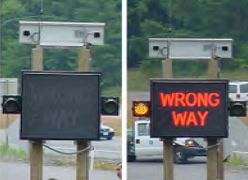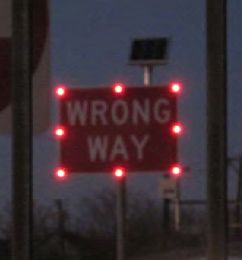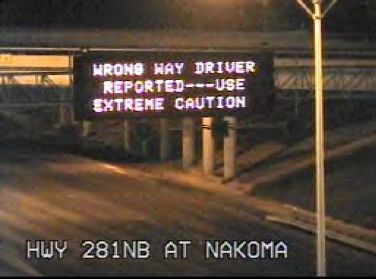Roads Safety: Texas Department of Transportation US 281 wrong-way drivers
by Brian
2 comments
Stopping wrong-way drivers
In San Antonio and across Texas, there has been a rash of wrong-way drivers (WWD) over the past few years. In San Antonio last year, there was a WWD about every other day. Fortunately, 80% of those drivers caused no accidents. But sadly, seven people were killed by WWDs last year. Of no surprise was that the majority of WWDs were intoxicated.
To combat the problem, several agencies formed the San Antonio Wrong Way Driver Task Force in March 2011. Those agencies include TxDOT, SAPD, City of San Antonio Public Works Department, Bexar County Sherrif’s Office, and Texas Transportation Institute, and the Federal Highway Administration. The task force worked to determine the extent and characteristics of the local problem, evaluate previous research and countermeasures, and formulate a plan to test and implement countermeasures locally.
After crunching the data, it was determined that the most WWD incidents occurred between midnight and 6am with Saturday night/Sunday morning being the worst by far (nearly twice that of Friday nights, which was the second most dangerous.)
In determining the worst locations, engineers found that it was nearly impossible to ascertain the exit ramp where the WWD entered. In fact, the wrong way entry point could be identified in just five cases last year. Furthermore, focusing on specific ramps limited the effectiveness of the evaluation of the issue or any subsequent countermeasure programs. Therefore, the problem was scoped by corridor. In that context, the US 281 corridor from downtown to Stone Oak showed the most WWD incidents.
Next, the group evaluated potential countermeasures. One of the first suggestions made by the general public is the use of wrong-way spike devices like those used in parking lots. However, previous research and testing has shown that these devices are not the obvious panacea many folks think them to be. Here are some of the problems noted in the task force’s report:
- Such devices are only designed for low-speed locations (< 10 mph).
- When tested in a high-speed location, even after being modified, the spikes did not cause the tires to deflate quickly enough to prevent the vehicle from entering the freeway and making significant progress.
- During testing in a high-speed location, the spikes often broke, making the device useless for its intended purpose and, furthermore, damaging the tires of vehicles headed in the right direction.
- Many right-way drivers perceived the devices as a hazard and hit their brakes, thus creating a hazardous condition.
- The devices were slippery during wet weather.
- Dirt, debris, and ice build up in the devices, preventing the spikes from folding down properly for right-way drivers.
Not mentioned in the report is the fact that even if spikes worked as intended, that would leave a disabled vehicle in the middle of an exit ramp, most often in the dark, thus presenting a serious traffic hazard for other drivers.
Given all these factors, spike strips are just a bad idea all around.
 San Antonio is not the first city to encounter this problem, and therefore other countermeasures were available for evaluation. One of the first things looked at was enhanced static signing. TxDOT has already developed a checklist for increasing the visibility of static wrong-way signage and markings and has implemented that scheme on most ramp locations in San Antonio. They are now considering additional “supplemental” measures including oversized signs as needed.
San Antonio is not the first city to encounter this problem, and therefore other countermeasures were available for evaluation. One of the first things looked at was enhanced static signing. TxDOT has already developed a checklist for increasing the visibility of static wrong-way signage and markings and has implemented that scheme on most ramp locations in San Antonio. They are now considering additional “supplemental” measures including oversized signs as needed.
SAPD currently relies almost exclusively on the public to report WWDs. All but one of the WWD incidents last year was first reported by the public (the other one was observed by a TransGuide operator.) To improve the detection of WWDs, various detection devices can be employed. These can be installed on exit ramps as well as on the main lanes and can alert SAPD and TransGuide dispatchers within seconds of a WWD being detected.
 Also evaluated were “active” warning signs that either light-up or flash red borders when activated by a detection device. These can also be placed on exit ramps and/or the main lanes.
Also evaluated were “active” warning signs that either light-up or flash red borders when activated by a detection device. These can also be placed on exit ramps and/or the main lanes.
Finally, physical channelization (i.e. the use of traffic islands to shunt traffic in the proper direction) on frontage road driveways was evaluated.
To determine the effectiveness of these devices, TxDOT selected the US 281 corridor from downtown to Stone Oak for a test project. Wrong-way detection devices and active signage will be placed on each exit ramp in the corridor as well as at four main lane locations: south of Encino Rio, south of Thousand Oaks, south of Loop 410, and north of Hildebrand. In addition, TxDOT will continue their practice of putting WWD warnings on the TransGuide dynamic message signs. After the devices are installed, the effectiveness of these measures will be evaluated. Work has already started and the system is expected to go online in mid February 2012. Design work on a second corridor– I-35 from US 90 to I-37– is underway. Because of the unique features of that corridor, including double-decked sections and non-typical exit ramps, different countermeasures may be employed. Depending on the outcome of these projects, the system may be expanded to the rest of the city’s freeway system.
Hopefully, these countermeasures prove effective at solving a problem that is simply getting out of hand.
More information
